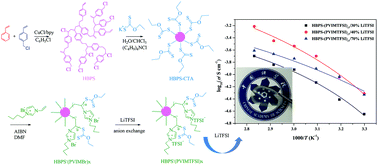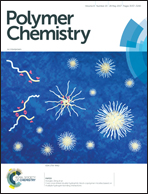The synthesis of a hyperbranched star polymeric ionic liquid and its application in a polymer electrolyte†
Abstract
This research provides an effective approach to synthesize a hyperbranched star polymeric ionic liquid (HBPS-(PVIMBr)x) with a hyperbranched polystyrene core and poly(1-butyl-3-vinylimidazolium bromide) arms via a combination of atom transfer radical self-condensing vinyl polymerization (ATR-SCVP) and RAFT polymerization. The synthesis process ensures good structural controllability and consistency that all of the arms of the star polymers are ionized. The obtained star polymeric ionic liquid shows good thermal stability with initial thermal decomposition temperatures above 290 °C. Moreover, after anion exchange, the TFSI− anion based hyperbranched star polymeric ionic liquid (HBPS-(PVIMTFSI)x) is used as the all-solid polymer electrolyte for lithium-ion batteries. The electrolytes (HBPS-(PVIMTFSI)x/LiTFSI) fabricated by the solution casting method exhibit a high room temperature ionic conductivity (4.76 × 10−5 S cm−1, the quantitative ratio of LiTFSI to the polymer matrix is 40%), a wide electrochemical window (4.9 V) and great interfacial compatibility.



 Please wait while we load your content...
Please wait while we load your content...